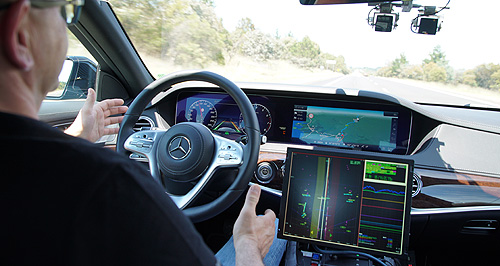News - General News - Autonomous TechnologySharper GPS to aid autonomous drivingClose call: Autonomous vehicles will be one of the beneficiaries of more accurate GPS in Australia, thanks to a $225 million in federal funding to Geoscience Australia. Driverless cars get $225m budget boost to make GPS accurate to within centimetres9 May 2018 A $225 MILLION project to improve the accuracy of the Global Positioning System (GPS) in Australia to as little as three centimetres will help pave the way for autonomous vehicles within four years. The funding to Geoscience Australia was announced in this week’s 2018-19 federal budget after the federal Space Policy Unit raised concerns that the current GPS, with its accuracy of only five to 10 metres, was inadequate for modern transport, mining, agriculture and industry. In effect, Australia will have two positioning systems – one that employs mobile phone coverage with the GPS satellite signals to narrow positioning accuracy to between three and five centimetres in “near-real time”. The other, for when no mobile phone coverage is available, uses American GPS with a Satellite-Based Augmentation System (SBAS) to accurately plot position in, for example, oceans and outback regions to an accuracy of 10cm. SBAS has been under trail by Geoscience Australia under a $12 million project announced last year by the federal government. The testing has been done in league with GPS users in agriculture, aviation, construction, mining and land and sea transportation. The government estimates the more accurate GPS systems will provide up to $73 billion in economic benefit by 2030. One of the big winners will be agriculture that will have far more accuracy when planting and reaping crops by GPS guidance. The other big winner will be transport, with trucking companies improving efficiency and driverless vehicles becoming much more feasible. Current GPS systems are insufficiently accurate to guide a vehicle within a traffic lane, meaning a heavy reliance on other technologies such as lane-keeping video sensors. When lane markings are indistinct or non-existent, vehicle systems have to throw control back to the driver, meaning true level-five driverless vehicles become impossible without accurate GPS. The government says in its budget papers that the new GPS systems will reduce barriers to accessing and using positioning, navigation and timing (PNT) data to allow Australian businesses to maintain their competitive advantage in industries such as agriculture and resources, and in emerging sectors such as automated transport. The spending announced in this year’s budget will be split into two – $64 million over four years on the PNT data using mobile phone coverage and $160.9 million on the regional and maritime system.  Read more |
Click to shareGeneral News articlesResearch General News Motor industry news |

















Facebook Twitter Instagram